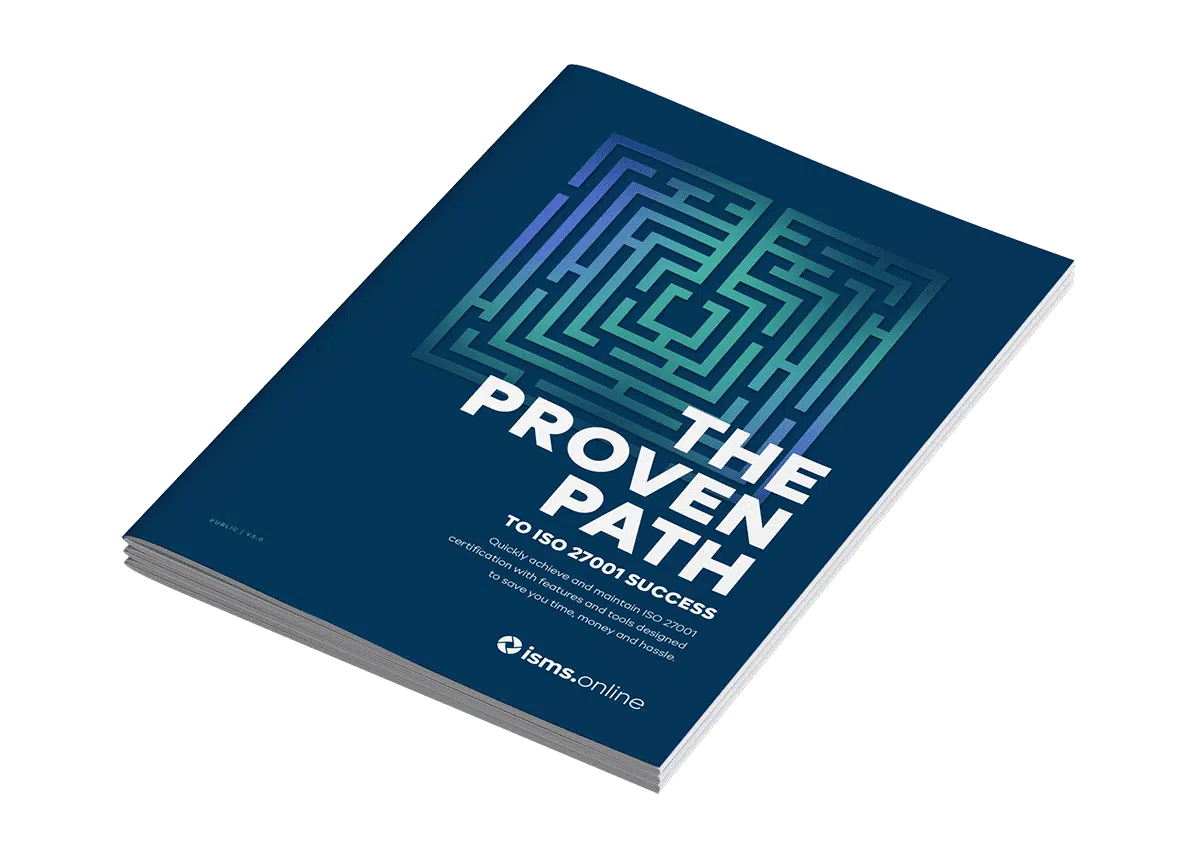
ISO 27001 Certification vs SOC 2 Attestation
Table Of Contents:
- 1) Market Applicability
- 2) The Business Case For ISO 27001 vs SOC 2
- 3) SOC 2 In A Nutshell
- 4) ISO 27001 in a Nutshell
- 5) ISO 27001 vs SOC 2 Comparison
- 6) What Are the Key Differences Between SOC 2 and ISO 27001?
- 7) SOC 2 vs ISO 27001 Implementation Time Frames
- 8) Which Security Standard/Framework Is Right for Your Business?
Are you trying to decide if you should adopt ISO 27001 or SOC (Service Organization Control) 2?
Both are strict information security frameworks developed to help organisations identify, manage risks, prevent data breaches and lawsuits. ISO 27001 auditors assess key areas like organisational management processes, vendor management, network security, and asset management. On the other hand, SOC (Service Organization Control) 2 auditors mainly assess internal controls over financial reporting, security controls, and compliance.
SOC 2 and ISO 27001 are two leading frameworks for measuring companies’ security controls and systems. They both offer strategic frameworks for operationalising and measuring your information security controls, but what are the main differences?
Both allow you to compare your company’s security controls to industry best practices. However, depending on your company’s needs, one might be a better fit.
This article will provide an ISO 27001 vs SOC 2 comparison, including what they are, what they have in common, which is suitable for your organisation, and why.
Market Applicability
A global standard, ISO 27001, is recognised by businesses and governments. It is widely implemented worldwide, but US companies have historically been more likely to look to SOC 2.
ISO 27001 certification and SOC 2 attestation are well-known business differentiators. Clients accept them as proof that a firm has robust information security policies and controls in place.
Being ISO certified or maintaining SOC 2 attestation by an independent third party adds value to an organisation’s brand.
Although both are equally “horizontal” in being accepted by most industries, there are specific industries and organisations that only accept one over the other. If you sell to organisations in the United States, they will likely accept SOC 2. ISO 27001, on the other hand, ISO 27001 accepted in Europe, Asia and the US by companies who operate internationally.
The Business Case For ISO 27001 vs SOC 2
You may have seen the news that Microsoft will no longer accept SOC 2 audits as proof of information security compliance from 2022.
“Microsoft has announced that they will no longer accept SOC 2 reports with security coverage as appropriate documentation beyond December of 2021. Going forward, they will accept ISO 27001 certification in lieu of the security portion of the DPR and ISO/IEC 27701 in lieu of the privacy portion of the DPR. If you attain both ISO 27001 and ISO/IEC 27701 certifications together, you should satisfy Microsoft SSPA requirements.”
Given the nature of SOC 2 audits attestation, Microsoft is sending a strong signal that ISO 27001 (ISMS) and ISO 27701 (PIMS) management system certifications demonstrate an organisation’s commitment to a robust and resilient information security posture. We expect similar requirements as other organisations mirror Microsoft’s requirements.
SOC 2 In A Nutshell
SOC 2 is a framework developed by the American Institute of Certified Public Accountants that sets out criteria for satisfactory internal controls in system security, availability, processing integrity, confidentiality and privacy.
An external auditor produces an attestation report to confirm an organisation’s level of compliance. The American Institute of Certified Public Accountants (AICPA) developed the compliance framework for these reports.
Five Trust Services Criteria determine the SOC 2 compliance journey; Security, Availability, Processing Integrity, Confidentiality, and Privacy.
In industries with higher compliance standards, such as finance, demonstrating compliance with all five Trust Service Criteria gives an organisation a competitive edge.
The content of a SOC 2 report does not require an objective “pass or fail” component, only the auditor’s opinion, which is subjective, therefore audit reports are not certifiable against SOC 2; they can only be attested as compliant with SOC 2 requirements, and only a licensed CPA can perform this attestation.
SOC 2 Reports Type 1 and Type 2 Explained
- In Type 1 reports, services’ systems are described, and the proposed controls support the organisation’s objectives.
- A Type 2 report examines the services’ systems and determines whether the proposed controls support the objectives the organisation wants to achieve and whether these controls work as expected over time.
Trust Service Criteria (TSC) & SOC 2 Compliance:
SOC 2 is not a linear checklist of controls, tools, or processes to follow. Rather than outline specific practices and processes, the document outlines the criteria that need to be met in order for an organisation to maintain strong information security.
Security, availability, confidentiality, processing integrity, and privacy comprise the five SOC 2 criteria (formerly the SOC 2 principles), and each category has a set of specific criteria to meet the respective points of focus.
How ISMS.online Makes SOC 2 Compliance Easy
With ISMS.online, you can: Manage risks, identify vulnerabilities, create control frameworks, checklists and access control policies, Develop your control environment, and Implement and Maintain your controls with ongoing management activities ensuring first-time attestation.
ISO 27001 in a Nutshell
ISO 27001 is an internationally recognised information security management standard. Organisations of any size or industry can adopt and implement an information security management system (ISMS) using its specifications.
As part of the ISO 27001 standard, best practices are selected from 114 Annex A controls (ISO 27002), which cover a wide range of aspects of an organisation, including human resources, information technology, and legal and physical security. Risk assessments and information security policies are used to identify and implement these controls.
How ISMS.online Helps With 27001 Certification
ISMS.online provides everything for ISO 27001 compliance, including regulatory checklists, documentation templates, mapping to relevant standards, user guides, automated policy control management and more.
Our pre-configured ISMS comes with tools, frameworks, access control and policies and controls, actionable data protection practices, documentation and guidance to help you meet every ISO 27001 requirement.
By adhering to our Adopt, Adapt, Add (AAA) philosophy, you’ll have made 82% progress as soon as you log in. Our pre-configured ISMS comes with tools, frameworks, policies and controls, actionable documentation and guidance to help you meet every ISO 27001 requirement.
ISO 27001 vs SOC 2 Comparison
SOC 2 and ISO 27001 are widely recognised certifications. Is one better than the other? It depends on who you talk to; they are both complementary. An organisation may choose to implement one and not the other. Likewise, an organisation may decide to implement both.
Despite some key differences, ISO 27001 and SOC 2 are helpful resources for organisations in evaluating and improving their security posture based on best practices and industry standards.
- There are a number of similarities between SOC 2 and ISO 27001 when it comes to security controls, such as processes, policies, and technologies that protect sensitive data.
- Since both frameworks address confidentiality, integrity, and availability of information, there are significant overlaps between their controls.
They both build customer trust by mitigating information security risks and require independent security control assessments.
What Do ISO 27001 and SOC 2 Have in Common?
As with SOC 2 attestation, the ISO 27001 certification process follows the same three stages of certification: gap analysis/assessment, implementation, and independent audit.
As mentioned earlier, both frameworks are governed by similar controls and overlap in some areas. Due to this, if your organisation becomes SOC 2 audited and ISO 27001 certified, the controls can be mapped, making the certification process or attestation easier since your organisation can already demonstrate compliance.
Clients and partners will feel confident that your organisation is taking information security seriously and will safeguard their privacy.
What Are the Key Differences Between SOC 2 and ISO 27001?
SOC 2 and ISO 27001 state that organisations should adopt controls only if they apply, but their approaches differ slightly.
- At their core, both are structurally different.
- The SOC 2 audit primarily aims to verify that the security controls protecting customer data are in place.
- A key aspect of ISO 27001 is creating and maintaining an Information Security Management System, an overarching methodology for managing data protection practices. Risk assessments, identification and implementation of security controls, and regular reviews of their effectiveness are necessary to achieve compliance.
- SOC 2 comprises five Trust Services Principles: Security, Availability, Processing Integrity, Confidentiality, and Privacy.
- There is a greater acceptance of ISO 27001 internationally.
- SOC 2 is attested by a licensed CPA firm.
- From the date of the report, type 1 and type 2 SOC 2 reports are remain valid within the industry for 12 months.
- ISO 27001 is certified by an ISO 27001-accredited certification body.
- A certificate of ISO 27001 is valid for three years with a surveillance audit every year.
Certification vs Attestation, What’s the Difference?
The term “SOC 2 certification” is not an accurate statement. An external audit is required to certify or achieve attestation. An ISO 27001 information security management system can be certified, whilst SOC 2 auditors can only offer attestation.
- Certification bodies issue ISO 27001 certificates. A recognised ISO 27001-accredited certification body must complete ISO 27001 certification.
- The issuing certification body can easily verify ISO 27001 certifications in the vendor management process.
- A SOC 2 attestation report can only be performed by a licensed CPA (Certified Public Accountant).
- In an attestation report, the third-party assessor documents a conclusion about the reliability of a written statement, to which the organisation they are assessing is held responsible.
- Instead of a certification audit like ISO 27001, the organisation’s auditors conclude an opinion based on the design and effectiveness of the control operation for each Trust Services Criteria.

SOC 2 Attestation – Audit & Report Opinions Explained
A SOC 2 attestation report is often 100 pages in length; this is completed by a 3rd party auditor and demonstrates proof of SOC2 control implementation.
The fact that a company has obtained a SOC 2 audit can be advertised on its website. No one can tell you whether you passed or failed.
Although you cannot fail a SOC 2 report, auditor report opinions may be noted as “modified” or “qualified”.
What Is a Modified or Qualified Opinion in a SOC 2 Audit?
An auditor’s role during a SOC 2 examination is to provide an opinion on your organisation. The auditor determines if the controls pass or need “modifications” or “qualifications” to paint a more accurate picture of your organisation’s security posture during this process.
SOC 2 reports are not public documents but can be shared with existing and potential clients. It is a sure bet that once they get it, they will dig, deep-especially if the industry has strict regulations, like finance. Organisations that employ third-party service providers to manage their data assets may also request a copy of the organisation’s audited report from these providers to verify the service provider’s credentials and security procedures.
Can You Fail a SOC 2 Audit?
The SOC 2 examination cannot technically be “failed”, but there are instances in which the assurance report opinion is “qualified” or “modified” due to control design or operation deficiencies.
If one or more controls are deficient, the organisation must revise them before re-attestation. Modifications/Qualifications can occur if any of the following occurs: Controls did not function as intended; Controls did not operate as planned; Controls were improperly implemented; Controls did not have adequate documentation; and/or Lack of internal controls or weaknesses in the controls framework that prevented the assessment team from satisfactorily completing the assessment.
When a prospect or customer receives your SOC 2 report, chances are they’ll turn to section two first, the independent service auditor’s report.
In this section, they’ll see whether your auditor deemed the effectiveness of an organisation’s controls and offers an opinion describing whether the controls are designed appropriately and implemented effectively to ensure the protection of customer assets.
In short, this section of the report provides an overall summary of the effectiveness of your information security program. Any findings will be noted in the report as graded and labelled as qualified opinions, disclaimer opinions or, in rare cases, adverse opinions.
For many reasons, an auditor may add a “modification” or “qualification” to a report. Within the “basis for opinion” section of the report, the auditor will describe the reasons for the modification, providing the organisation with helpful information. Each opinion will be accompanied by a brief description detailing why the change was made to the rating of the reported controls. With this information in hand, the company can take the necessary steps to address any shortcomings and ensure its information assets are adequately protected. Finally, suppose a company does have an adverse opinion. In that case, it means there are significant risks to the security of its information assets, and the company is not doing enough to protect its systems.
Unqualified SOC 2 Reports
An unqualified opinion indicates that the audit was successful. More specifically, the auditor tested controls that were designed and operating as intended. These controls demonstrate effectiveness in protecting company data, including sensitive personal information of customers/clients.
Qualified Opinion
A qualified opinion means the auditor found that one or more controls were not designed and/or operated as needed.
Essentially, a qualified report is a failing grade. It should be noted, however, that ineffective control or controls might not impact specific customers or prospects.
Disclaimer Opinion
A disclaimer opinion means that an organisation provided too little information to the auditor. An auditor in this situation could not provide an opinion on compliance with SOC 2.
Adverse Opinion
An adverse opinion means customers and prospects can’t place any trust in your systems.
In other words, you failed the test! Most organisations hold themselves to a high standard in protecting their critical business data, which explains why most organisations successfully pass their examinations and receive unqualified reports. Occasionally, some organisations receive an adverse opinion because their internal controls are inadequate.
Not all adverse opinions are the same. The severity of an unfavourable opinion in a SOC 2 audit depends on the findings’ nature, extent and impact. For example, an inadequate backup plan could result in an unqualified recommendation, but a poorly designed authentication system could result in an adverse finding. The severity of an audit finding is at the discretion of the independent service auditors performing the audit.
ISO 27001, From Audits to Certification
ISO 27001 simply provides a certificate, an official document proving an organisation’s certification status.
Achieving ISO 27001 certification requires both an internal audit and an external audit performed by a qualified auditor. The auditor presents the organisation with a chance to address or provide proof of intent to address any non-conformities within a given time period. During this time, minor and major non-conformities and opportunities for improvement are identified.
The important distinction between SOC 2 attestation and ISO 27001 certification is that the ISO 27001 auditor and the certification body are separate entities. The auditor will submit evidence of compliance and non-conformities to the certification body for approval. The ultimate decision to approve ISO 27001 certification lies with the Certification body.
SOC 2 vs ISO 27001 OPEX & Costs
Both certification and attestation have similar operational expenditure (OPEX) implementation costs for implementing security controls and gathering the evidence required to prove compliance with SOC 2 or ISO 27001. The main difference lies in the approach to implementing and maintaining the required security controls and the documentation needed to prove compliance. In general, the OPEX SOC 2 audits performed annually can be more onerous long term.
Depending on the scope of an organisation’s ISMS, ISO 27001 can initially cost 50%-60% more than SOC, although pricing varies widely across industries.
With certification and attestation, one of the primary objectives is to reduce the likelihood of breaches and regulatory fines, which will save money long term.
SOC 2 vs ISO 27001 Implementation Time Frames
To achieve certification or attestation, you must ensure that your organisation’s security practices are up to date.
A certification project consists of four stages: gap assessment, risk assessment, implementation, and certification. Many of the security controls in SOC 2 and ISO 27001 are the same, so the implementation and evidence collection times should be similar.
Which Security Standard/Framework Is Right for Your Business?
The intended outcome of any information security programme is to increase third-party confidence in an organisation’s security controls and mitigate the risk of fines or penalties.
The choice between SOC 2 and ISO 27001 will ultimately depend on an organisation’s needs and how the chosen framework and its controls align with their current practice and market applicability.
- ISO 27001 requires annual surveillance audits and recertification every 3 years.
- SOC 2 audits are mandatory once per year, in some cases once every 3 months.
- This can place an onerous burden on business.
- ISO 27001 involves more work, but it does more to protect organisations from information security threats.
- SOC 2 attestation is not awarded by an independent certification body, which means there is greater scope for a level of “mark your own homework” dishonesty.
- The information security industry appears to be moving away from SOC 2 as the golden standard and gravitating towards ISO 27001.
Looking to achieve your first ISO 27001 certification? The Assured Results Method, ARM, breaks down the whole process into simple steps and helps you achieve ISO 27001 the first time. The assured results method shows you how to take advantage of every shortcut, avoid every pitfall along the way and shares simple, practical guidance right through to certification or compliance.
When to Choose ISO 27001?
Companies that want to implement a more rigorous assessment standard or need to build an ISMS can benefit from ISO 27001. Certification to ISO 27001 requires more effort and investment, but the organisation’s security credibility will be enhanced. This can be beneficial if the company wants to expand internationally, has clients that demand it, or needs to meet regulatory requirements for securing sensitive data.
When to Choose SOC 2?
If you are conducting business solely in North America or need a lighter-weight, cheaper audit, look into SOC 2 audits.
How ISMS.online Helps With SOC 2 Compliance?
From SOC 2 gap assessment to demonstrating compliance for the attestation audit, ISMS.online helps your business achieve SOC2 attestation and maps your controls against ISO 27001.
Get Certified to SOC 2 and ISO 27001 at the Same Time
SOC 2 audits are helpful for organisations with an existing Information Security Management System that want to spot-check their current policies and controls. In addition to surfacing key insights, these audits can help organisations customise their security assessments.
Additionally, organisations may consider undertaking both certification and attestation to demonstrate a well-rounded security program compliant across borders or if they are looking to satisfy international compliance requirements.
Our SOC 2 and ISO 27001 mapping provides a clear path between the two frameworks, helping you attain certification and attestation efficiently.
Final Thoughts
Whilst SOC 2 trust services criteria is more common in North America and has gained some traction internationally, Pursuing ISO 27001 certification is more rigorous as it demonstrates a more substantial commitment to information security, making it more desirable in certain industries.
As noted earlier, Microsoft has endorsed ISO 27001 over SOC 2, effective December 2021, and whilst this may not mean the timely demise of SOC 2, other multinational companies will likely follow suit with similar requirements from their supply chains.
How ISMS.online Makes ISO 27001 Certification Easy?
Getting ISO 27001 certified is no mean feat. It can be overwhelming and confusing. ISMS.online simplifies and streamlines the entire process.
Our platform maps the control commonalities between ISO 27001 and SOC 2 helping your business streamline its compliance needs. Contact us today for more information or book a demo.





